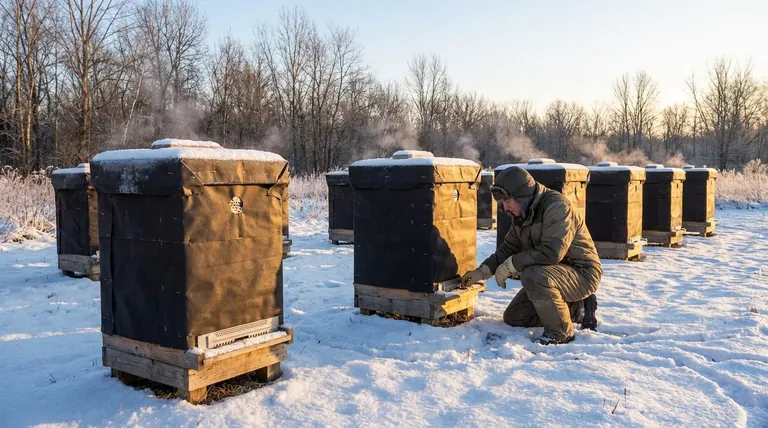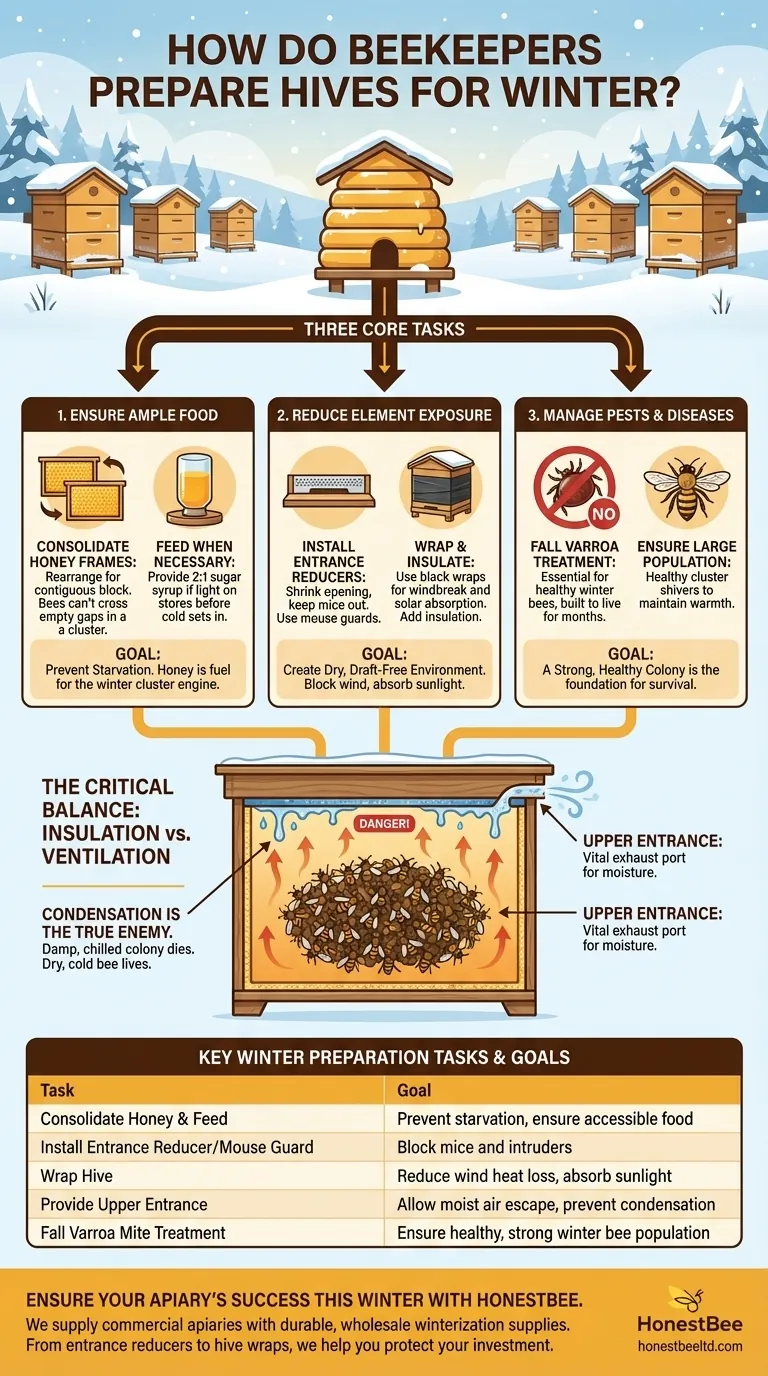To prepare a hive for winter, beekeepers focus on three core tasks: ensuring the colony has ample food, reducing its exposure to the elements, and managing pests and diseases. This involves consolidating honey frames, feeding sugar syrup if needed, installing entrance reducers to keep mice out, and wrapping the hive to block wind and absorb sunlight.
The goal of winter preparation is not to heat the hive, but to create a dry, draft-free environment where the bees can efficiently use their own food stores to generate heat and survive until spring. The greatest threats are starvation and moisture, not cold alone.

The Foundation: A Strong and Healthy Colony
A colony's ability to survive winter is determined long before the first frost. Preparations begin in late summer and early fall.
Ensure a Large Population
A large population of healthy bees is essential for generating enough heat. The bees form a winter cluster, shivering their flight muscles to maintain a survivable temperature at the cluster's core. A smaller colony has less thermal mass and will struggle to stay warm.
Manage Pests and Disease
Winter bees are physiologically different from summer bees; they are built to live for months, not weeks. It is critical that this generation of bees is healthy.
Beekeepers must conduct Varroa mite tests and treatments in the fall. A colony weakened by this pervasive parasite is unlikely to have the strength or numbers to endure the long winter months.
Securing Winter Food Stores
Starvation is a leading cause of colony death during winter. The bee's winter cluster is a living engine, and honey is its fuel.
Consolidate Honey Frames
Beekeepers rearrange frames inside the hive to ensure all the honey is in one contiguous block, typically in the upper hive bodies. Bees in a tight winter cluster may be unable to cross even a small gap of empty frames to reach food on the other side, causing them to starve just inches away from honey.
Feed When Necessary
If a colony is light on honey stores after the final harvest, the beekeeper must provide supplemental food. This is usually done by feeding a heavy 2:1 sugar syrup (two parts sugar to one part water) in the fall, giving the bees time to store it before cold weather sets in.
Fortifying the Hive Structure
The physical hive must be secured against both weather and intruders seeking warmth and food.
Reduce the Entrance
An entrance reducer is a small piece of wood that shrinks the main opening of the hive. This gives the colony a smaller, more defensible space to guard against robbing insects and, most importantly, prevents mice from entering and nesting in the warm, protected hive. A mouse guard serves the same primary purpose.
Wrap and Insulate the Hive
Many beekeepers wrap their hives, often in black tar paper or specially designed hive wraps. This accomplishes two things: it provides a critical windbreak to prevent heat from being stripped away, and the black color absorbs solar radiation on sunny days, helping to warm the hive wall.
Additional insulation can be placed on the hive bodies or under the cover to help regulate temperature and reduce drafts, mimicking the thick walls of a natural tree cavity.
The Critical Balance: Insulation vs. Ventilation
Properly wintering a hive requires managing a delicate trade-off. While insulation is beneficial, sealing a hive too tightly can be a fatal mistake.
Condensation is the True Enemy
As the bee cluster consumes honey and "shivers" to create heat, they release a significant amount of warm, moist air through respiration. If this moisture cannot escape, it will rise, hit the cold inner cover of the hive, and condense. This cold water will then drip back down onto the bees, chilling and killing the cluster far more effectively than outside air temperature.
A Dry, Cold Bee is a Live Bee
A colony can survive extreme cold as long as it is dry and has access to food. A damp, chilled colony cannot. Therefore, ensuring adequate ventilation is often more important than providing heavy insulation.
The Upper Entrance: A Vital Exhaust Port
To combat condensation, many beekeepers provide a small upper entrance or ventilation port. This opening, often just a one-inch hole drilled in the top hive body, allows the warm, moist air to escape. This simple feature is a safety valve that keeps the hive interior dry. The hive wrap should also have a corresponding hole.
Making the Right Choice for Your Colony
Your winterization strategy should be adapted to your specific climate and goals.
- If your primary focus is surviving a harsh, windy winter: Prioritize a robust windbreak and wrapping the hive to minimize heat loss from convection.
- If your primary focus is navigating a damp, wet winter: Ensure you have an upper entrance for ventilation, as managing condensation will be your biggest challenge.
- If your colony's food stores seem low after harvest: Begin supplemental feeding with sugar syrup early in the fall to give them time to prepare.
- If you are in any climate: Always install a mouse guard and confirm your colony is as free from Varroa mites as possible before winter begins.
By managing food, pests, moisture, and physical security, you give your bees the best possible chance to emerge strong and ready for the spring.
Summary Table:
| Key Winter Preparation Task | Primary Goal |
|---|---|
| Consolidate Honey Frames & Feed | Prevent starvation, ensure accessible food stores |
| Install Entrance Reducer/Mouse Guard | Block mice and intruders |
| Wrap Hive for Windbreak & Solar Gain | Reduce heat loss from wind, absorb sunlight |
| Provide Upper Entrance for Ventilation | Allow moist air to escape, prevent deadly condensation |
| Fall Varroa Mite Testing & Treatment | Ensure a healthy, strong population of winter bees |
Ensure your apiary's success this winter with the right equipment from HONESTBEE.
We supply commercial apiaries and beekeeping equipment distributors with durable, wholesale-focused supplies designed for demanding conditions. From robust entrance reducers and mouse guards to effective hive wraps and feeding essentials, our products help you implement the critical winterization steps outlined above.
Let us help you protect your investment and ensure strong, healthy colonies come spring. Contact HONESTBEE today to discuss your wholesale needs and get your operation winter-ready.
Visual Guide

Related Products
- Wholesales Dadant Size Wooden Bee Hives for Beekeeping
- Professional Galvanized Hive Strap with Secure Locking Buckle for Beekeeping
- Black Plastic Beetle Barn Hive Beetle Trap for Beehives
- Automatic Honey Flow Beehive 4 Frame Mini Hive for Beekeeping
- Langstroth Screen Bottom Board for Beekeeping Wholesale
People Also Ask
- Why were wooden hives traditionally preferred? For Natural Beekeeping Aligned with Bee Biology
- What types of products are available for beekeeping needs? Essential Equipment for Apiaries & Distributors
- How often should the area under beehives be inspected and cleaned during the warm season? A Proactive Maintenance Guide
- What is beekeeping equipment? Essential Tools for Commercial Apiaries & Distributors
- What are the advantages of wooden bee hives? Superior Bee Health & Beekeeper Flexibility



















